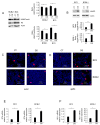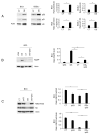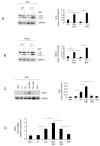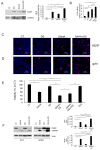EZH2 Inhibition by DS3201 Triggers the Kaposi's Sarcoma-Associated Herpesvirus Lytic Cycle and Potentiates the Effects Induced by SAHA in Primary Effusion Lymphoma Cells
- PMID: 39339966
- PMCID: PMC11437442
- DOI: 10.3390/v16091490
EZH2 Inhibition by DS3201 Triggers the Kaposi's Sarcoma-Associated Herpesvirus Lytic Cycle and Potentiates the Effects Induced by SAHA in Primary Effusion Lymphoma Cells
Abstract
Primary Effusion Lymphoma (PEL) cells carry Kaposi's sarcoma-associated herpesvirus (KSHV) in a latent state, except for a small number of cells in which the virus replicates to ensure its persistence into the infected host. However, the lytic cycle can be reactivated in vitro by exposing these lymphoma cells to various treatments, leading to cell lysis. To restrict viral antigen expression, KSHV induces repressive epigenetic changes, including DNA methylation and histone modifications. Among the latter, histone deacetylation and tri-methylation of Histone H3 lisyne-27 (H3K27me3) have been reported to play a role. Here, we found that the inhibition of H3K27 tri-methylation by valemetostat DS3201 (DS), a small molecule that inhibits Enhancer of Zeste Homolog 2 (EZH2) methyltransferase, induced the KSHV lytic cycle in PEL cells, and that this effect involved the activation of the wtp53-p21 axis and autophagic dysregulation. DS also potentiated the lytic cycle activation mediated by the Histone deacetylases (HDAC) inhibitor Suberoylanilide hydroxamic acid (SAHA) and reinforced its cytotoxic effect, suggesting that such a combination could be used to unbalance the latent/lytic cycle and further impair the survival of PEL cells.
Keywords: KSHV; PEL cells; autophagy; lytic cycle; p53.
Conflict of interest statement
The authors declare no conflicts of interest.
Figures





Similar articles
-
Repurposing Cytarabine for Treating Primary Effusion Lymphoma by Targeting Kaposi's Sarcoma-Associated Herpesvirus Latent and Lytic Replications.mBio. 2018 May 8;9(3):e00756-18. doi: 10.1128/mBio.00756-18. mBio. 2018. PMID: 29739902 Free PMC article.
-
Efficacious proteasome/HDAC inhibitor combination therapy for primary effusion lymphoma.J Clin Invest. 2013 Jun;123(6):2616-28. doi: 10.1172/JCI64503. Epub 2013 May 1. J Clin Invest. 2013. PMID: 23635777 Free PMC article.
-
Activation of Kaposi's sarcoma-associated herpesvirus (KSHV) by inhibitors of class III histone deacetylases: identification of sirtuin 1 as a regulator of the KSHV life cycle.J Virol. 2014 Jun;88(11):6355-67. doi: 10.1128/JVI.00219-14. Epub 2014 Mar 26. J Virol. 2014. PMID: 24672028 Free PMC article.
-
[Replication Machinery of Kaposi's Sarcoma-associated Herpesvirus and Drug Discovery Research].Yakugaku Zasshi. 2019;139(1):69-73. doi: 10.1248/yakushi.18-00164-2. Yakugaku Zasshi. 2019. PMID: 30606932 Review. Japanese.
-
Regulation of KSHV Latency and Lytic Reactivation.Viruses. 2020 Sep 17;12(9):1034. doi: 10.3390/v12091034. Viruses. 2020. PMID: 32957532 Free PMC article. Review.
Cited by
-
Modulatory Effect of Curcumin on Expression of Methyltransferase/Demethylase in Colon Cancer Cells: Impact on wt p53, mutp53 and c-Myc.Molecules. 2025 Jul 22;30(15):3054. doi: 10.3390/molecules30153054. Molecules. 2025. PMID: 40807229 Free PMC article.
-
Targeting EZH2 in Cancer: Mechanisms, Pathways, and Therapeutic Potential.Molecules. 2024 Dec 10;29(24):5817. doi: 10.3390/molecules29245817. Molecules. 2024. PMID: 39769907 Free PMC article. Review.
References
-
- Montaner S., Sodhi A., Pece S., Mesri E.A., Gutkind J.S. The Kaposi’s sarcoma-associated herpesvirus G protein-coupled receptor promotes endothelial cell survival through the activation of Akt/protein kinase B. Cancer Res. 2001;61:2641–2648. - PubMed
Publication types
MeSH terms
Substances
Grants and funding
LinkOut - more resources
Full Text Sources
Research Materials
Miscellaneous

